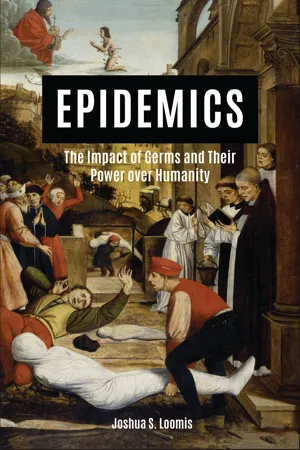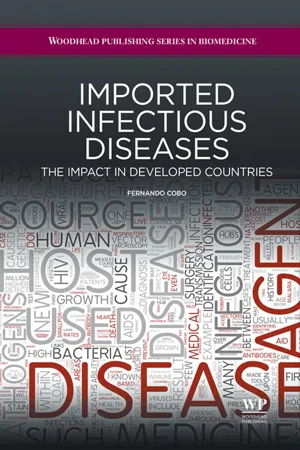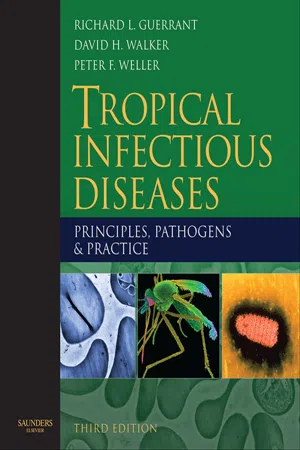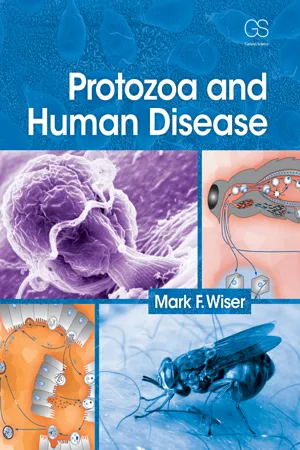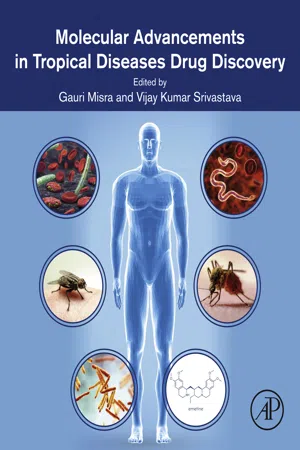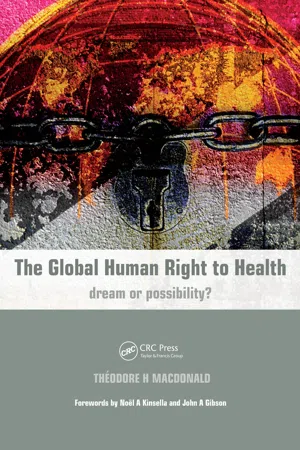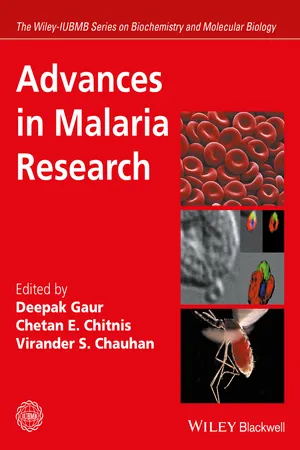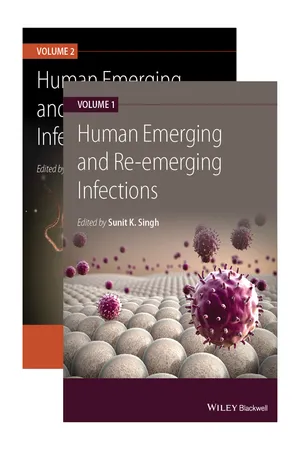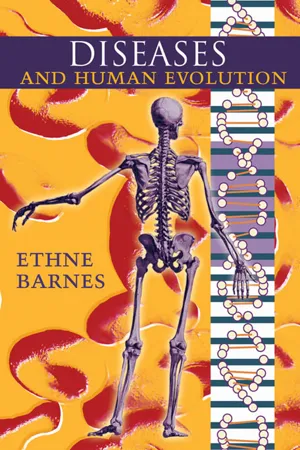Biological Sciences
Malaria
Malaria is a life-threatening disease caused by parasites transmitted to people through the bites of infected female Anopheles mosquitoes. It is a major global health problem, particularly in tropical and subtropical regions. Symptoms include fever, chills, and flu-like illness, and if not treated promptly, malaria can be fatal. Control measures include the use of insecticide-treated bed nets and antimalarial drugs.
Written by Perlego with AI-assistance
Related key terms
1 of 4
Related key terms
1 of 3
12 Key excerpts on "Malaria"
- eBook - ePub
Epidemics
The Impact of Germs and Their Power over Humanity
- Joshua S. Loomis(Author)
- 2018(Publication Date)
- Praeger(Publisher)
2Malaria is caused by infection with one of four species of the parasite Plasmodium (P. falciparum, P. Malariae, P. ovale, and P. vivax). Plasmodium is not a type of bacterium or virus but rather a unicellular protozoan that has a complex cellular structure (like that of humans) and a life cycle that involves both its mosquito vector and human host. About 30–40 different species of mosquitoes, all belonging to the genus Anopheles, naturally serve as vectors for Plasmodium parasites.After a mosquito bites an infected person and takes in a blood meal, the parasite undergoes a type of sexual reproduction in the gut of the mosquito and proceeds to invade the cells that line its gut.3 After further replication in those cells, new parasite production causes gut cells to burst, releasing the parasite sporozoites. The sporozoites spread to the salivary glands of the mosquito and wait for it to bite another human. Upon landing on a new host, the mosquito inserts its mandibles and the maxillae into the skin and promptly injects its saliva, which has potent anticlotting and pro-inflammatory properties (allowing blood to flow freely). Plasmodium sporozoites found in the mosquito saliva enter into the bloodstream of the new host and quickly migrate to the liver, where they invade host hepatocytes.In many cases, the sporozoites will sit dormant inside the hepatocytes for several days, weeks, or even months before proceeding to the next stage of its life cycle.4 This asymptomatic incubation period varies for each of the four Plasmodium species that cause Malaria. Once it becomes activated, it undergoes reproduction inside of the liver cell, causing it to burst and release parasite cells that are now called merozoites. These merozoites move into the blood of the host and invade red blood cells (RBCs) there. Once inside RBCs, the parasite drastically increases its size, ingests host hemoglobin, and undergoes several rounds of reproduction. The infected RBCs eventually pop, releasing a large number of new merozoites that are capable of infecting even more RBCs. This cycle of infection, growth, reproduction, and release from RBCs will repeat about every 2–3 days (depending on the Plasmodium - eBook - ePub
- Jacques Derek Charlwood(Author)
- 2019(Publication Date)
- CRC Press(Publisher)
CHAPTER 12The Diseases – Malaria, Filariasis and Dengue MalariaMuch of the information below comes from Professor Sir Nick White’s chapter in Manson’s Tropical Diseases (White, 2003).Malaria is a protozoan disease of the red blood cells transmitted by the bite of an infected mosquito (Figure 12.1 ). It has been described since ancient times. In his Epidemics, Hippocrates describes the regular attacks of intermittent fever associated with the different parasites. Fever is one of its classical symptoms. In Europe, seasonal fevers were associated with marshes. In Latin, palus means marshy ground and hence the French term Paludisme. In Italian, it was also associated with often pungent marshes mal (bad) air, hence Malaria. It has perhaps been responsible for half of all human deaths since Homo sapiens first walked the Earth and despite recent gains in control remains a leading cause of death in Africa, where 89% of the world’s Malaria deaths occur. In Africa, it is also responsible for 25%–35% of all outpatient visits and 20%–45% all hospital admissions. It is especially severe in pregnant women and causes an estimated 400,000 severe pregnancy-related cases and 10,000 maternal deaths every year. It is an economic problem as well as a health problem and costs an estimated $12 billion a year and in Africa is considered to slow economic growth by 1.3% a year.There are five species of human Malaria: Plasmodium falciparum, P. vivax, P. Malariae, P. ovale and P. knowlesi.The life cycle of the parasite, first described by Ronald Ross, involves sexual reproduction in the mosquito and clonal reproduction in the human (Figure 12.2 ).Frequent crossing occurs between different clones of parasite during sexual reproduction in the mosquito (Babiker et al., 1995).Only a few (maybe 6–10) sporozoites are injected by the mosquito. Within 45 minutes they have either found refuge in a hepatocyte in the liver or have been killed by erythrocytes. In the liver, a phase of asexual reproduction takes place. (All reproduction in the human is asexual.) After 5.5 days for P. falciparum or 15 days for P. Malariae - eBook - ePub
Imported Infectious Diseases
The Impact in Developed Countries
- Fernando Cobo(Author)
- 2014(Publication Date)
- Woodhead Publishing(Publisher)
6Current status of Malaria
Abstract
Malaria is a major international public health problem causing around 500 million infections worldwide and approximately one million deaths every year. Transmission occurs in large areas of Africa, central and South America, the Caribbean, Asia, eastern Europe and the South Pacific. Malaria is a rare diagnosis in Europe, the US and other developed countries, but it is a medical emergency. A travel history or living in endemic areas are the key to suspecting Malaria, and this is a priority in patients with fever. There is no specific clinical symptomatology and immigrants from endemic regions might have mild symptoms. The diagnosis must be performed quickly on suspicion. Rapid diagnostic tests (RDTs) should be performed but the gold standard is microscopy.Key words MalariaPlasmodium speciestransmission public health problem microscopy rapid diagnostic tests emergency6.1 Disease and pathophysiology
Malaria remains an uncommon infection in non-endemic areas. Its name is derived from the belief of the ancient Romans that Malaria was caused by the bad air of the marshes surrounding Rome.Malaria is characterised by recurrent fever and chills associated with the lysis of parasitised red blood cells. However, Malaria symptoms are non-specific and cannot easily be distinguished from a wide range of other diseases, so a high degree of suspicion and a travel history are needed for the diagnosis.Although exact data are difficult to obtain, Malaria could be considered one of the most common infectious diseases worldwide. Globally there are 500 million infections per year, leading to a million deaths. The majority of deaths is caused by Plasmodium falciparum infection and occurs in children younger than five years who live in sub-Saharan Africa.The prevalence of Malaria varies widely, but it might reach 70–80% among children in hyperendemic areas during the transmission season. The major factors for the re-emergence of Malaria are both drug resistance of the mosquito vector, Anopheles , to insecticides (e.g. chlorophenothane) and to treatment with chloroquine and pyrimethamine–sulfadoxine by P. falciparum - Richard L. Guerrant, David H. Walker, Peter F. Weller(Authors)
- 2011(Publication Date)
- Saunders(Publisher)
CHAPTER 96 MalariaStephen L. Hoffman, Carlos C. (Kent) Campbell, Nicholas J. WhiteIntroduction
Access the complete reference list online at http://www.expertconsult.comMalaria is an acute systemic illness caused by infection with Plasmodium falciparum , P. vivax , P. Malariae , P. ovale , or P. knowlesi , all of which are transmitted to humans by female Anopheles species mosquitoes. There are an estimated 500–800 million clinical cases of Malaria and 1 million deaths due to Malaria annually in the tropics and subtropics (Fig. 96.1 ).1 The majority of infections and deaths are caused by P. falciparum infection of children in sub-Saharan Africa. In fact, P. falciparum is responsible for more deaths in children <5 years of age than any other single infectious agent. In Africa, Malaria is estimated to result in a minimum economic loss of US$12 billion annually.2Figure 96.1 Areas of the world where Malaria is transmitted, with differentiation between high- and minimal-risk areas.(Reproduced from World Health Organization. Available online at: http://gamapserver.who.int/mapLibrary/default.aspx .)All symptoms, signs, and pathologic features of Malaria are caused by the asexual erythrocytic stages of the parasite. This stage involves invasion of normal erythrocytes by parasites, intraerythrocytic replication of the parasites over 2–3 days (Table 96.1 ), rupture of erythrocytes, and parasite reinvasion of normal erythrocytes. This exponential parasite replication in the bloodstream can increase parasite densities by 5–30-fold every 1–3 days depending on the Plasmodium species.Table 96.1 Differences among Plasmodium falciparum, P. vivax, P. ovale, P. Malariae , and P. knowlesiMalaria caused by any of the five Plasmodium species is characterized by fever, chills, diaphoresis, malaise, headache, and other systemic symptoms and signs indistinguishable from illnesses caused by many viral and bacterial pathogens. P. falciparum is responsible for almost all Malaria deaths. This is in large part due to two unique features of the parasite (Table 96.1 ). Only P. falciparum invades erythrocytes of all ages, meaning that the percentage of erythrocytes infected can reach levels as high as 80% (>2 × 106 parasites/µL blood depending on the degree of anemia), thereby increasing the chance that the infection will cause serious disease. Only P. falciparum secretes proteins that form knobs on the surface of the infected erythrocyte which then bind to endothelial cells in the microcirculation of the brain, kidneys, intestines, and other organs during the second half of the parasite’s 43–52-hour development cycle in erythrocytes. These adherent infected erythrocytes are responsible for microcirculatory obstruction, leading to decreased blood flow and oxygen delivery, and local inflammatory responses critical to the pathogenesis of the severe manifestations of disease that make P. falciparum- eBook - ePub
- Mark F Wiser(Author)
- 2010(Publication Date)
- Garland Science(Publisher)
15 MalariaDisease(s)Malaria Etiological agent(s)Plasmodium falciparum, P vivax, P ovale, P MalariaeMajor organ(s) affectedBlood Transmission mode or vectorAnopheline mosquitoes Geographical distributionTropical and subtropical regions throughout the world Morbidity and mortalityCauses an acute febrile disease that in the case of P. falciparum can develop into a complicated disease involving several organs and lead to death if not treatedDiagnosisDetection of parasites in blood TreatmentChloroquine, mefloquine, quinine, Fansidar®, artemisinin derivatives combined with other drugs, plus others Control and preventionMosquito avoidance such as use of bed nets, repellents, protective clothing; chemical or biological control of mosquitoes and destruction of breeding areas; case detection and treatment Among the diseases caused by protozoa, Malaria probably has the greatest impact upon humans. It has been, and still is, the cause of much human morbidity and mortality and an estimated 1.5–2.7 million people die of Malaria every year. Although the disease has been eradicated in many temperate zones, it continues to be endemic throughout much of the tropics and subtropics. Forty percent of the world’s population lives in endemic areas. Epidemics have devastated large populations and Malaria poses a serious barrier to economic progress in many developing countries due to the severe clinical disease that often accompanies infection. There are an estimated 300–500 million cases of clinical disease per year. The impact of Malaria on humans is further illustrated by some of the earliest known medical writings from China, Assyria, and India which accurately describe the Malaria-like intermittent fevers. However, Hippocrates is generally credited with the first description of the clinical symptoms in 500 BC, more than 2000 years before the parasite and life cycle were described (Table 15.1 - Gauri Misra, Vijay Kumar Srivastava(Authors)
- 2020(Publication Date)
- Academic Press(Publisher)
Plasmodium falciparum . Microbiol Mol Biol Rev 2014;78(3):469–486.5.3. Epidemiology and risk factors
As mentioned earlier, although the number of Malaria cases are reduced, the progress of elimination and control is halted throughout the world. Malaria is majorly found in tropical and subtropical regions and spread through the bite of female Anopheles mosquitoes [36 ]. The global distribution of Malaria mainly relies on the mosquito vectors and out of 400 different Anopheles species around 31–40 vectors are called as “physiologically competent vectors” (Fig. 5.3 ) [4 ,37 ], which are capable enough to develop the infectious parasites despite their occurrence in experimental conditions in the laboratory [38 ].This vector mainly bites between dusk and dawn and the transmission of disease mainly depends on the climate and environmental conditions together with local vector (mosquito) behavior [4 ]. Moreover, the incidence of Malaria has also been influenced by other factors such as vector control, human host, and parasites which are strict anthroponoses without any animal reservoirs, and therefore it is indistinguishably linked to the poor and socioeconomic unstable countries, areas affected with natural calamities and war with inadequate resources [36 ]. Transmissions from mother to child or through the blood transfusion are few of the less common routes, however at higher risk in the area with restricted resources [36 ]. Out of all four major Plasmodium parasites, P. falciparum accounts for 99.7% Malaria incidence in WHO African regions and P. vivax is the predominant in WHO American regions representing 74.1% Malaria cases [4 ]. The other remaining species P. Malariae , P. ovale , and newly emerged P. knowlesi from the Malaysia also accounts for Malaria; however, the rate of incidence is low [36- eBook - ePub
The Global Human Right to Health
Dream or Possibility?
- Theodore Macdonald, Richard Mayon-White(Authors)
- 2018(Publication Date)
- CRC Press(Publisher)
European exploration of tropical countries, and the gradual incorporation of those countries into various European empires, have served to make Malaria an important part of the developed world’s history and thought. The development of Malaria as a parasitic disease, both within the mosquito and then within the Malaria victim, is a complex one, and it took almost a century to work out even the basic details. Such understanding, though, did gradually equip people with the means to protect themselves against infection.To even gain a rudimentary understanding of how defence mechanisms can be elaborated against the ravages of Malaria, the reader must appreciate – at least at an elementary level – how Malaria is vectored by the mosquito and how the parasite responsible develops both in the mosquito and in the infected person. The strategy for fighting Malaria has mainly focused on finding weak links in its complex developmental cycle – in both the mosquito and the infected person – and trying to prevent completion of the cycle.A brief account of how Malaria infection works
The parasite that causes Malaria is a single-celled organism which is carried, or vectored, from one person to another by the females of various species of mosquito belonging to the Anopheles genus. The parasite itself belongs to the genus Plasmodium . Four species of Plasmodium can cause Malaria, namely Plasmodium falciparum , Plasmodium vivax , Plasmodium ovale and Plasmodium Malariae . It is P. falciparum that causes the vast majority of Malaria cases. We shall now consider the cycle, starting at the point where the mosquito bites a person and thereby injects some P. falciparum parasites in the ‘protozoite’ form.- Only species of mosquito belonging to the genus Anopheles can vector (transmit) Malaria. There are 380 species of Anopheles , only 60 of which are able to vector the parasite. One of these mosquitoes, itself already infected, bites the person and some protozoites of the parasite pass from the mosquito’s salivary gland into the person’s veins. Since males of Anopheles
- eBook - ePub
- Felipe Kierzenbaum(Author)
- 2013(Publication Date)
- Academic Press(Publisher)
4Malaria
Eleanor M. Riley, Lars Hviid and Thor G. TheanderPublisher Summary
This chapter discusses human Malaria, which is caused by infection by one of the four species of Plasmodium, of which P. falciparum is the most pathogenic. The classic symptoms of Malaria, such as fever and malaise with intermittent paroxysms, are typical of P. vivax, P. Malariae, and P. ovale Malaria. Human Malaria infections tend to become synchronous, with large numbers of schizont-infected erythrocytes rupturing within a short space of time. Thus, the typical pattern of fever seen in Malaria is associated with the cyclic maturation of asexual stages. Fever spikes coincide with schizont ruptures. In areas with stable endemic P. falciparum Malaria, parasitemia is most common in young children, and the incidence of parasitemia declines steadily with age. The acquisition of antiMalarial immunity is slow, developing gradually after years of exposure. The precise timing of the events depends on the local patterns of Malaria transmission and levels of endemicity. Multiple Malaria infections are necessary to achieve effective antiparasite immunity.I Introduction
Human Malaria is caused by infection with one of four species of Plasmodium, of which P. falciparum is the most pathogenic. The classic symptoms of Malaria—fever and malaise with intermittent paroxysms—are typical of P. vivax, P. Malariae, and P. ovale Malaria. The symptoms of P. falciparum Malaria, which is geographically the most widespread of the human Malarias, are generally more severe, and if left untreated the disease is frequently fatal in nonimmune individuals. It is for this reason that much of the effort in recent years to develop a Malaria vaccine has focused specifically on P. falciparum. - eBook - ePub
- Deepak Gaur, Chetan E. Chitnis, Virander S. Chauhan, Deepak Gaur, Chetan E. Chitnis, Virander S. Chauhan(Authors)
- 2016(Publication Date)
- Wiley-Blackwell(Publisher)
CHAPTER 4 The biology of Malaria transmission Robert E. SindenThe Malaria Centre, Department of Life Sciences, Imperial College London, London, UKThe Jenner Institute, University of Oxford, Oxford, UKPurpose
For the purposes of this text, transmission is defined as the progression of Plasmodium from a vertebrate host through the mosquito vector until inoculation into the next vertebrate host. Thus this chapter examines the biology of the infectious gametocyte in the vertebrate host, of the sexual and sporogonic development in the mosquito vectors, and of the delivery of infectious sporozoites into the proboscis of the mosquito.History
Since the 1970s, the focus of Malaria research has been on the cyclic development of the pathogenic asexual blood stages of Plasmodium falciparum; it is therefore perhaps necessary to recall that Plasmodium was first identified when Laveran saw the explosive emergence of the male gametes in a sample of blood taken from a soldier in Tunis (Laveran 1881). The appreciation of the role of these lashing cells was memorably summarized by Manson in his advice to Ross: “Follow the flagellum!” In so doing, Ross discovered that it was mosquitoes that are the most common vectors of Plasmodium (Ross 1897), and Grassi and colleagues recognized that Anopheles transmitted the Malaria parasites to humans (Grassi 1900). McCallum soon recognized that the flagellum was indeed the male gamete and that fertilization took place in the mosquito, resulting in the formation of a motile “vermicule” (MacCallum 1897), thus making the vectors the definitive hosts of Plasmodium.Recognition of the key role of the mosquito in transmission led to the early and very effective implementation of environmental, housing, and personal schemes to reduce human–vector contact and the early introduction of both residual and targeted household insecticide spraying campaigns, notably in the protection of colonial forces. The success of the introduction of DDT into such campaigns is difficult to overestimate. - eBook - ePub
- Sunit Kumar Singh, Sunit Kumar Singh(Authors)
- 2015(Publication Date)
- Wiley-Blackwell(Publisher)
Chapter 21 Pathogenesis of Malarial Parasites in Humans Caroline Lin Lin Chua1 , Ricardo Ataíde2 , Alexandra J. Umbers3 , and Philippe Boeuf21 Taylor's University Lakeside Campus, School of Biosciences, Subang Jaya, Selangor, Malaysia2 Burnet Institute, Centre for Biomedical Research, Melbourne, Victoria, Australia3 Department of Medicine, University of Melbourne, Melbourne, Victoria, Australia21.1 Current global Malaria situation
Enter the discourse: Is Malaria a re-emerging tropical disease? Or, is Malaria declining? Viewed either way, one thing is certain: Malaria has not disappeared. We have reached a tipping point that requires a balance of both sustained improvements in disease control and ongoing investment into containing emerging threats.The prevalence of Malaria is becoming polarized: the spectrum of which is determined by the complex interaction between vast improvements in limited areas, stagnation in others, mounting international and financial investment, and unforeseen emerging challenges. Whether Malaria is indeed a re-emerging disease also depends on the frame of reference. During the global Malaria eradication programme of the mid-twentieth century, the opportunity for eradication in parts of Africa was abandoned all but too early. In the following decades, Malaria elimination was largely neglected, making it one of the most prevalent tropical diseases in the world. Fortunately, a wave of international commitment to tackle the unacceptably high burden of disease has been revived: it seems Malaria has finally re-emerged as a public health priority this century.The World Health Organization (WHO) estimates that rates of Malaria have declined by a quarter since 2000 (World Health Organization, 2013), largely due to scaled-up implementation of treatment and control measures. Yet, despite the decline, Malaria remains one of the most common and preventable infectious diseases and half the world's population continue to live in Malaria-endemic areas. Each year, 219 million new Malaria infections still occur resulting in a loss of almost 700,000 lives (World Health Organization, 2012), mostly in African children. Globally, 125 million pregnancies are exposed to Malaria (Dellicour et al., 2010), three quarters of which occur in the Asia-Pacific region. Although there have been recent declines, Latin America still accounts for 10% of the Malaria-exposed population worldwide (Herrera et al., 2012). More than 100 countries have ongoing Malaria transmission: 79 are in the control phase, 10 are in pre-elimination, another 10 are in the elimination phase, and an additional 5 are aiming to achieve interrupted transmission by 2015 (World Health Organization, 2012). In countries that are transitioning from low endemicity to elimination (including Bhutan, Sri Lanka, and Malaysia), cases of Malaria are increasingly clustered to hotspots (Cotter et al., 2013). - eBook - ePub
- Ethne Barnes(Author)
- 2007(Publication Date)
- University of New Mexico Press(Publisher)
Anopheles mosquitoes biting humans can sustain the plasmodia. Also, variation in susceptibility to the plasmodia exists within the same species, and each species has several variants. Not only do the mosquitoes have to be able to accept the parasites, they must survive long enough for them to reproduce and transmit their infectious offspring (Beck and Davies 1981; Horsfall 1972).Infective mosquitoes need to live close to human dwellings in large numbers for the cycle of Malaria to be maintained in the human population. The mosquitoes must be able to ingest a large number of infective forms of the parasite, and they must be willing to bite humans repeatedly. The cycle requires sufficient numbers of human and animal hosts to maintain the presence of the parasites. Climate and environment also have to be favorable for long-term mosquito survival and breeding (Beck and Davies 1981; Horsfall 1972).Regardless of the limitations on the transmission and maintenance of Malaria, Anopheles species capable of sustaining Malaria parasites exist in almost every part of the world. Infected African slaves brought Malaria to the New World. The parasites gained access to local Anopheles mosquitoes as they dined on the blood of the slaves. Thus, local Anopheles capable of accepting the plasmodia spread the disease in various parts of the Americas. Similarly, infected individuals from Malaria-infested regions introduced Malaria to Europe, parts of Central Asia, the Near East, and the Pacific Islands, and this danger still exists today. The introduction of the Malarial plasmodia into new Anopheles species created new strains of the parasites, some with greater or less vigor, depending on the new mosquito environment (Bates 1949).The most important mosquito vectors relevant to the rise and spread of Malaria come from the regions of the Old World where agriculture and animal husbandry took over, pushing out and replacing their natural wild animal hosts. Various Anopheles species and strains adapted to different geographic regions, differing in their choice of breeding places and blood feeding habits. Most Anopheles - eBook - ePub
- Irwin W. Sherman(Author)
- 2017(Publication Date)
- ASM Press(Publisher)
New York Times article had a more cautious (and realistic) headline: “A Malaria Vaccine Works, With Limits.” Although these results are encouraging, many challenges remain before this vaccine can be licensed for widespread use. For example, it required >600,000 sporozoites per subject to induce complete immunity, and even with this dosage, immunity persisted for only 1 year.Coda
Today, Malaria still ravages the continent of Africa. Its target is the indigenous peoples, and slowly and inexorably it is killing them. This is especially true in the rainy and low-lying agricultural areas, where transmission is high. In other areas the problem is famine and malnourishment. Malnourishment increases the susceptibility to Malaria and a variety of other diseases, leads to lower productivity, and puts a further strain on the already fragile health care system. Sadly, in Africa the riders of the Apocalypse have as their principal target the children; one out of three die from Malaria and a like number from AIDS. It is thus a certainty that in the 21st century Disease and Death will continue to ride together and influence the course of history.
Index pages curate the most relevant extracts from our library of academic textbooks. They’ve been created using an in-house natural language model (NLM), each adding context and meaning to key research topics.
Explore more topic indexes
Explore more topic indexes
1 of 6
Explore more topic indexes
1 of 4
